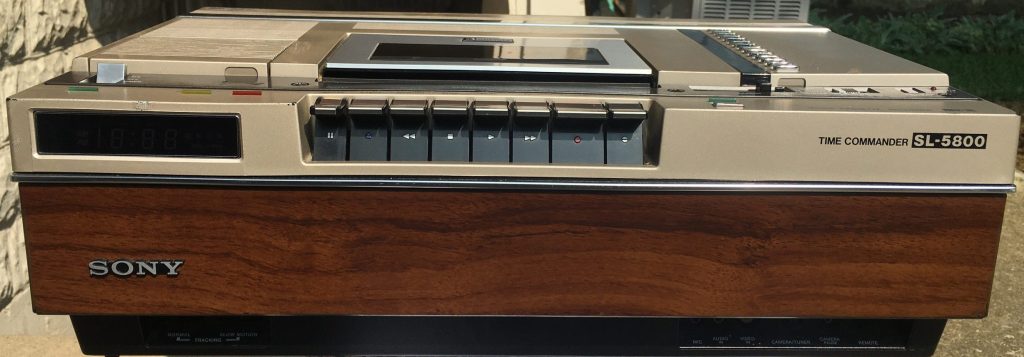8.5 The Influence of New Technology
New technologies have a profound impact, not only on the way films get made, but also on the economic structure of the film industry. When VCR technology made on-demand home movie viewing possible for the first time, filmmakers had to adapt to a changing market. The recent switch to digital technology also represents a turning point for film. This section will discuss how these and other technologies have transformed the cinematic landscape.
Effects of Home Entertainment Technology
The first technology for home video recording, Sony’s Betamax cassettes, hit the market in 1975. The device, a combined television set and videocassette recorder (VCR), came with a high price tag of $2,495, making it a luxury still too expensive for the average American home. Two years later, RCA released the vertical helical scan (VHS) system of recording, which would eventually outsell Betamax, though neither device had garnered the consumer’s support yet. Within several years, however, the concept of home movie recording and viewing began to catch on. In 1979, Columbia Pictures released 20 films for home viewing, and a year later Disney entered the market with the first authorized video rental plan for retail stores. By 1983, VCRs had not gained much traction, found in just 10 percent of American homes, but within two years the device had found a place in nearly one-third of U.S. households (Entertainment Merchant Association).
At the same time, video rental stores began to spring up across the country. In 1985, three major video rental chains—Blockbuster, Hastings, and Movie Gallery—opened their doors. The video rental market took off between 1983 and 1986, reaching $3.37 billion in 1986. Video sales that year totaled $1 billion, resulting in more than $4 billion in total revenue, marking the first time in history that video revenues surpassed box-office revenues ($3.78 billion that year) (Entertainment Merchant Association).
Video sales and rentals opened a new mass market in the entertainment industry—the home movie viewer—and offered Hollywood an extended source of income from its films. On the other hand, the VCR also exacerbated the problem of piracy.
The Betamax Legacy: Why a Dust-Covered VCR Still Holds the Key to AI Copyright

In an era when Hollywood was already struggling financially due to increased production costs, Sony’s release of home video recording technology became a major source of concern for Hollywood studios. If people could watch movies at home, would they stop going to the movies altogether? In the 1976 case, Sony Corp. of America v. Universal City Studios, Universal Studios, and the Walt Disney Company sued Sony in the U.S. District Court for the Central District of California. The suit argued that Sony manufactured a technology that could potentially break copyright law, and the company assumed liability for any copyright infringement committed by VCR purchasers. The District Court struggled with the case, eventually ruling against Sony. However, Sony appealed to the Supreme Court, where the debate continued. The case’s outcome had broad implications: Does a device with recording capabilities conflict with copyright law? Is an individual guilty of copyright infringement if she records a single movie in her own home for her private use?
Eventually, the Supreme Court ruled that Sony and other VCR manufacturers were not liable for copyright infringement. This case represented a significant milestone for two reasons. It opened up a new market in the entertainment sector, enabling video rental and home movie sales. Additionally, the case set a standard for determining whether a device with copying or recording capability violated copyright law. The court ruled that because nonprofit, noncommercial home recording did not constitute a copyright violation, VCR technology did have legitimate legal uses, and the courts could not hold Sony and other companies liable for any misuse of their devices. Movie studios may have initially lamented the ruling, but the decision opened up the home video market, which would become one of the most profitable aspects of the industry. Five years after the verdict, home market sales totaled $2.5 billion, accounting for approximately 22% of the $11.5 billion video market (Nichols, 1990).
This case has posed interpretive challenges in legal battles and debates over file sharing through the Internet (Spruill & Adler, 2009). Cases involving Napster, Grokster, Morpheus, and BitTorrent all demonstrate the ongoing debate over the extent to which the Sony ruling applies to modern file-sharing technologies and the challenges of balancing copyright protection with the promotion of innovation and fair use.
The case significantly impacts generative AI by establishing the “substantial non-infringing uses” doctrine, offering a potential defense for AI developers against copyright infringement claims. This principle asserts that a manufacturer of a technology capable of both lawful and infringing uses is not liable for contributory copyright infringement if the product has substantial non-infringing uses. In the context of generative AI, this means that even if an AI model’s output could infringe on copyrighted material, the AI developer might argue they are not liable if the model also has numerous legitimate, creative, and non-infringing applications. For example, AI models trained on vast datasets of text and images are being used to generate original stories, design new architectural concepts, or create unique musical compositions, none of which directly infringe existing works. This parallels the Betamax VCR, which could record copyrighted TV shows but also had “time-shifting” (watching later) as a legitimate, non-infringing use. However, the exact application remains highly debated, particularly when AI models “memorize” and reproduce copyrighted content or when their outputs directly compete with the market for the original works, leading to ongoing lawsuits against companies like OpenAI and Stability AI where the scope of “fair use” and “transformative use” in AI training and output is being rigorously tested.
The Optical Disc System
In 1980, around the time when consumers began purchasing VCRs for home use, Pioneer Electronics introduced another technology: the LaserDisc, an optical storage disc that produced higher-quality images than VHS tapes. Nonetheless, due to its large size (12 inches in diameter) and lack of recording capabilities, this early disc system never gained popularity in the U.S. market. However, the LaserDisc’s successor, the digital versatile disc (DVD), achieved far greater success. Like LaserDisc, the DVD stores encoded information that follows a spiral pattern on the disc’s surface that devices can read when illuminated by a laser diode. However, unlike the analog-formatted LaserDisc, the entirely digital DVD allows for a smaller, lighter, and more compressed medium.
The first DVDs appeared in stores in 1997, impressing consumers and distributors with their numerous advantages over VHS tapes: sharper resolution images, compactness, higher durability, interactive special features, and better copy protection. In only a few years, sales of DVD players and discs surpassed those of VCRs and videos, making the DVD the most rapidly adopted consumer electronics product of all time (Entertainment Merchants Association).

In 1999, Netflix revolutionized the movie rental market. Netflix began in 1997 as a video rental store in California. In 1999, the company introduced an online subscription service. Subscribers would select movies that they wanted to see on Netflix’s website, and the film would arrive in their mailbox a few days later, along with a prepaid return envelope. This allowed users to select from thousands of movies and television shows in the privacy of their own home.
The Blu-ray Disc format, intended for storing and producing high-definition video, eventually surpassed DVD technology. Released in 2006, the Blu-ray Disc technology has the same physical dimensions as DVDs, but the discs have more than five times the storage capacity of DVDs (Blu-ray). By 2009, there were 10.9 million Blu-ray Disc players in U.S. homes (Molbaek, 2009). 4K discs appeared a couple of years later; however, the increasing popularity of streaming platforms like Netflix, Hulu, and Amazon Prime Video has left many consumers opting for digital content rather than physical media. The percentage of American households with a dedicated Blu-ray player has likely continued to decline since 2018. However, the number of video game consoles capable of playing Blu-ray discs have grown.
DVD Decline and Growth of Streaming
DVD rentals and sales were once a cornerstone of the movie industry’s revenue, generating nearly half of the returns on feature films. For a period, the industry even exploited the profitability of releasing some movies directly to DVD without a theatrical premiere, or simultaneously with their theatrical release, maximizing early revenue streams. This “straight-to-DVD” model was prolific, with estimates suggesting that for every movie appearing in theaters, three bypassed cinemas entirely (Court, 2006). However, the economic shifts of the late 2000s, coupled with the rapid advancement of digital technologies, initiated a sharp and irreversible decline in physical media sales and rentals among U.S. consumers (Garrett, 2008).
The true disruptor emerged not from new physical formats like Blu-ray (which itself eventually waned), but from the burgeoning power of online digital downloads and, more significantly, streaming. Netflix, originally a DVD-by-mail service, shrewdly diversified its appeal starting in 2007 by offering subscribers instant streaming of movies and TV shows. This pivotal move allowed viewers to watch content on their computers, early handheld devices, and connected gaming consoles like the Nintendo Wii, Sony PlayStation 3, and Microsoft Xbox 360, without the need for a physical disc. This trend exploded, continuing on modern gaming systems from these companies (now PlayStation 5, Xbox Series X/S, and Nintendo Switch 2), smart TVs, and a vast array of dedicated streaming devices (e.g., Roku, Apple TV, Amazon Fire Stick). The shift from physical ownership to digital access reshaped consumer expectations, valuing convenience and vast libraries over disc collections.
Hollywood initially viewed online piracy as its most immediate digital threat. However, by the 2010s, studios began to strategically pivot, transforming this potential vulnerability into a new source of revenue through legitimate digital distribution. Platforms like Hulu, launched in 2007 as a joint venture by major broadcasters, offered a legal, ad-supported avenue for fans to access a select variety of popular movies and TV shows, mirroring the “free” access model of traditional broadcast television. This model quickly evolved; in April 2010, Hulu introduced Hulu Plus (later rebranded simply as Hulu’s ad-free tier or Hulu with Live TV), a fee-based service providing access to an expanded library and premium content (Reuters, 2010). Hulu, like many services that followed, focused on providing a seamless home-viewing experience through online streaming rather than allowing content downloads to personal devices, thus maintaining control over intellectual property (Hulu, 2010).
Today, the digital streaming landscape is vastly more complex and competitive. Beyond Hulu, giants like Netflix (which transformed into a global streaming behemoth), HBO Max, Disney+, Amazon Prime Video, and Apple TV+, among many others, dominate the market. These services operate primarily on subscription models, offering vast libraries of licensed content, original programming with blockbuster budgets, and often, early access to films shortly after their theatrical runs, or even simultaneous “day-and-date” releases. The revenue streams for studios are now heavily diversified across theatrical box office, PVOD (Premium Video On Demand) rentals/purchases, and licensing deals or direct subscriptions for their streaming platforms. Piracy remains a concern, but the industry’s focus has largely shifted to optimizing content release strategies across these myriad digital windows.
The Industry Goes Digital
In an industry where technological innovation can rapidly transform production or distribution, for over a century, most movies relied on celluloid film, the same material Thomas Edison used for his kinetoscope. The transition to digital filmmaking, while seemingly slow initially, gained irreversible momentum in the 21st century. George Lucas’s Star Wars Episode II: Attack of the Clones was indeed a pioneering major Hollywood film shot entirely on high-definition digital video. However, widespread adoption was gradual; much of the movie industry—including directors, producers, studios, and especially major movie theater chains—slowly embraced this profound shift in filming technology. At the time Attack of the Clones premiered, only a handful of theaters worldwide were equipped with digital projectors, highlighting the significant infrastructure challenge (Kirsner, 2006).
However, digital cinematography has since become the overwhelming standard for film production, offering a multitude of compelling advantages. During production, digital cameras virtually eliminate the need for costly and time-consuming film reloading, allowing directors to capture longer, uninterrupted takes (Kirsner, 2006). This digital format also radically streamlines the post-production process. Instead of physically scanning film negatives, digitally captured footage can be sent electronically to editing suites for immediate manipulation, special effects integration, and color grading. Furthermore, digital film files, when properly managed and stored, do not suffer from the physical degradation (scratches, dust, color shifts) inherent to celluloid film, consistently producing crystal-clear, high-resolution images (Taub, 2009).

For distributors and production companies, the economic benefits of digital production and distribution are immense. Digitally recorded images eliminate the considerable costs associated with purchasing, developing, and printing physical film stock. In the era of celluloid, studios spent hundreds of millions of dollars annually just making prints of films for distribution to theaters, plus additional significant costs to ship the heavy reels globally (Burr, 2002). For a major wide release that might go to thousands of screens, printing and shipping 35-mm film could easily cost tens of millions of dollars. In contrast, with a digital format, these costs are drastically reduced or disappear entirely, as files can be sent to theaters on a single hard drive or, increasingly, delivered securely over digital networks (cable, satellite, or dedicated internet lines), saving the industry millions (Carvajal, 2005; Burr).
The primary hurdle to this digital transition was initially the exhibition side. For theaters, the high upfront costs of making the digital switch – with high-quality digital projectors costing over $100,000 each – offered fewer immediate short-term incentives than the significant savings seen by distributors (Reuters, 2003). Moreover, many theaters had substantial existing investments in their 35-mm film projection equipment (Carvajal). However, the benefits of digital projection (ease of distribution, pristine image quality, and particularly the resurgence of 3-D content) eventually provided the necessary impetus, and virtually all commercial cinemas worldwide have now completed the conversion to digital projection.
Despite the operational benefits during production and distribution, digital film introduces new challenges for long-term archival storage. While traditional 35-millimeter masters, stored in controlled environments like subterranean mines, can have remarkable longevity (often hundreds of years if properly maintained), digital data presents different durability issues. Early digital formats like DVDs proved susceptible to rapid degradation, with uncertain lifespans. Hard drives, while more robust, require active management, including periodic operation to prevent data loss and regular migration of files to newer formats to prevent obsolescence as technology evolves. Consequently, the long-term storage and preservation costs for digital masters can sometimes be more expensive than traditional film archives due to the need for continuous oversight and format migration, a vital consideration given that studios generate significant revenue from the re-release of their extensive film libraries.
The Resurgence of 3-D
After World War II, as movie attendance began to decline with the rise of television, the motion picture industry experimented with new technologies to entice audiences back into theaters. One such innovation was the 3-D picture, which offered the novel experience of increased audience immersion, as objects appeared to extend into the theater space. This effect was achieved by mimicking human binocular vision: filmmakers used specialized camera rigs with two lenses spaced slightly apart, capturing separate images for the left and right eyes. In theaters, these images were projected simultaneously, and audiences wore polarized glasses to filter the projections, ensuring each eye received its intended image (Buchanan, 2008).
The initial 3-D boom was an instant sensation. House of Wax, released in 1953, became one of the year’s most successful films, grossing over $1 million in its first three weeks. The relatively inexpensive equipment required for 3-D production led to a rapid proliferation, with studios churning out dozens of such films in just two years. However, this initial popularity proved fleeting, already waning by the end of 1953 (Hayes, 2009). The “3-D headache” phenomenon, caused by technical inconsistencies in filming and projection (such as manual alignment of converging images and distortions from 35-mm film’s motion through cameras), contributed significantly to its rapid decline (Hayes).

For decades, 3-D migrated from mainstream popular entertainment to a novelty attraction, primarily found in IMAX cinemas, as an occasional marketing draw for children’s movies, and in theme-park experiences like Captain Eo at Disneyland (Rivera, 2009). However, new digital technologies brought about a significant resurgence of the trend in the late 2000s and early 2010s, transforming the contemporary 3-D experience from a mere gimmick into a more serious cinematic development. Pioneers like DreamWorks Animation CEO Jeffrey Katzenberg championed the new 3-D, likening its potential impact to the introduction of color (McCarthy).
Modern digital filmmaking addressed the technical flaws that plagued early 3-D. Computerized calibration now ensures perfect camera alignment, eliminating the “headache” issue. The digital recording format itself removes the celluloid-produced distortion. Furthermore, a single digital projector, often equipped with a sophisticated photo-optical device, can now perform the work that previously required two perfectly synchronized projectors. For theater chains, 3-D provided a compelling incentive to invest in digital projection, as audiences were willing to pay higher ticket prices for an immersive experience that could not be easily replicated at home. Films like James Cameron’s Avatar, which became the highest-grossing film of all time for many years, and Alice in Wonderland, powerfully demonstrated 3-D’s box office potential, with a significant portion of their earnings coming from 3-D ticket sales. While the initial fervor for 3-D has somewhat subsided in the mid-2020s, it remains a viable option for certain blockbusters and animated films, and the technology laid groundwork for further immersive formats.

